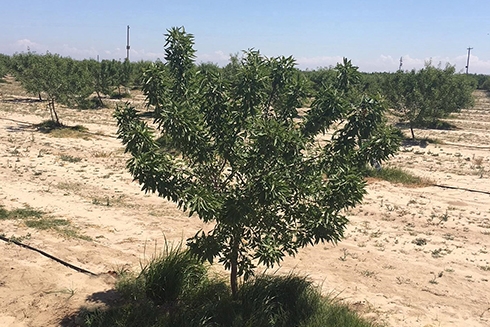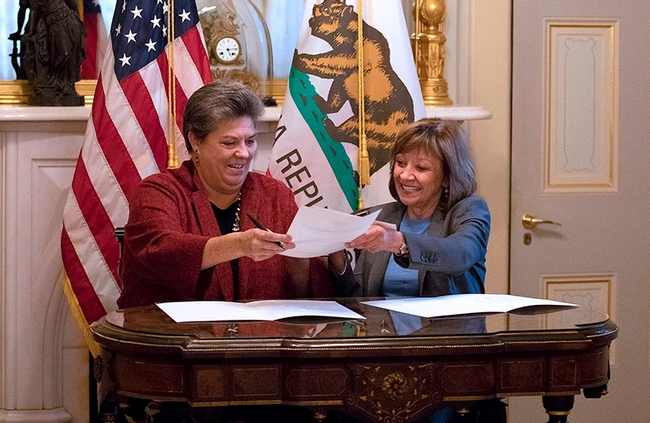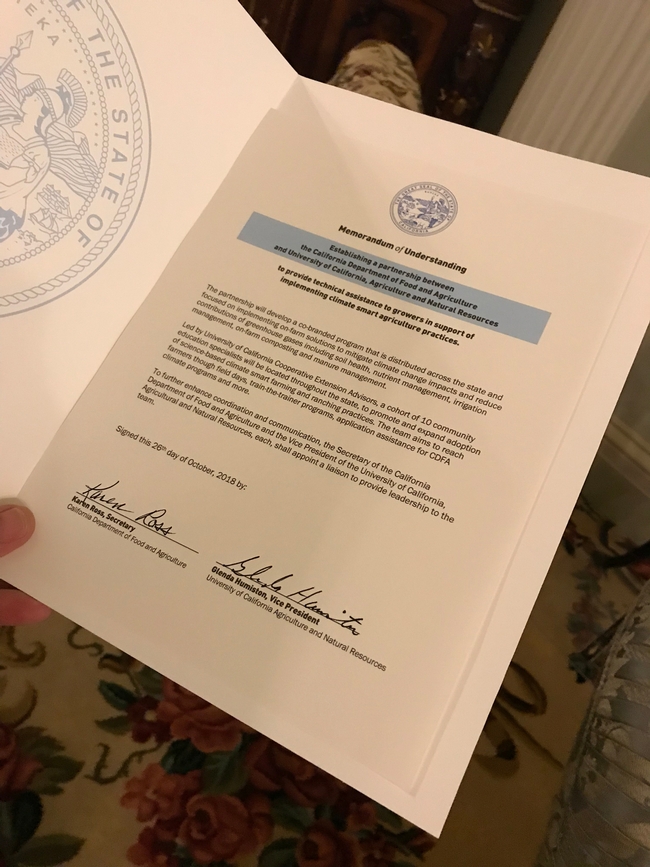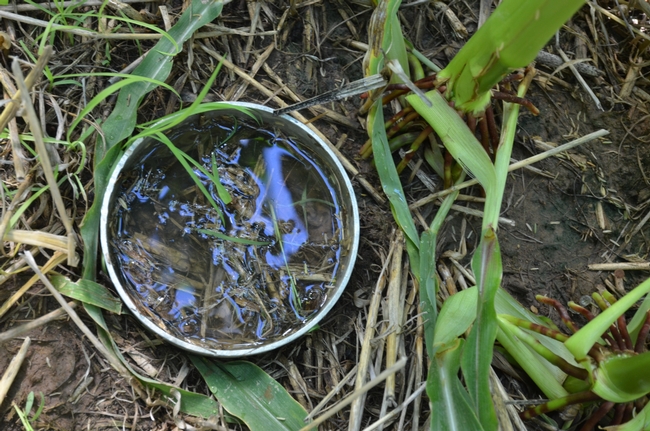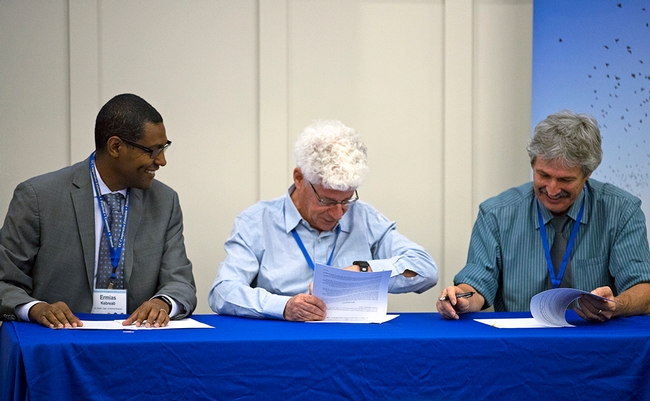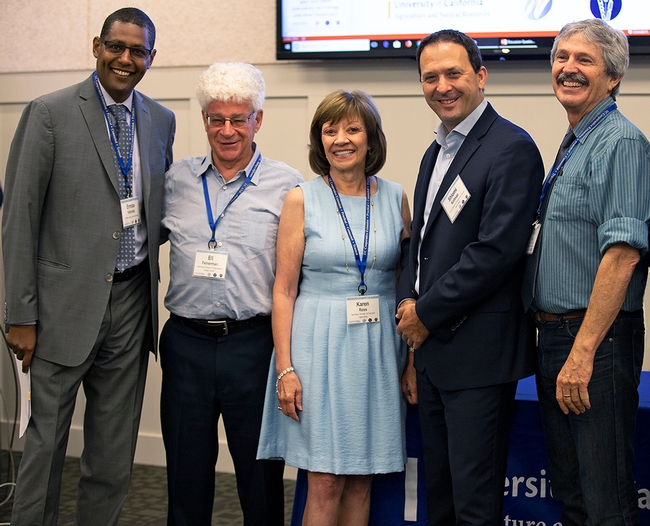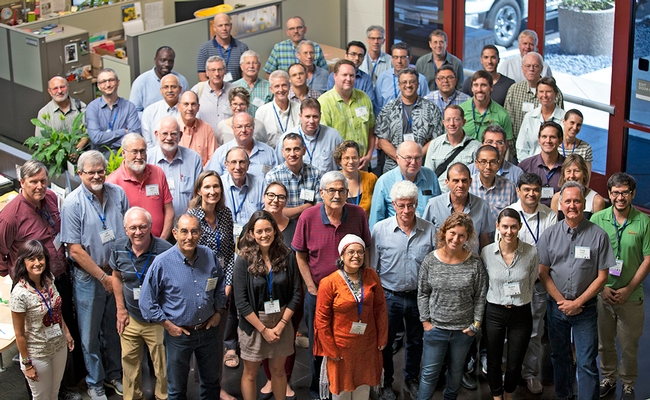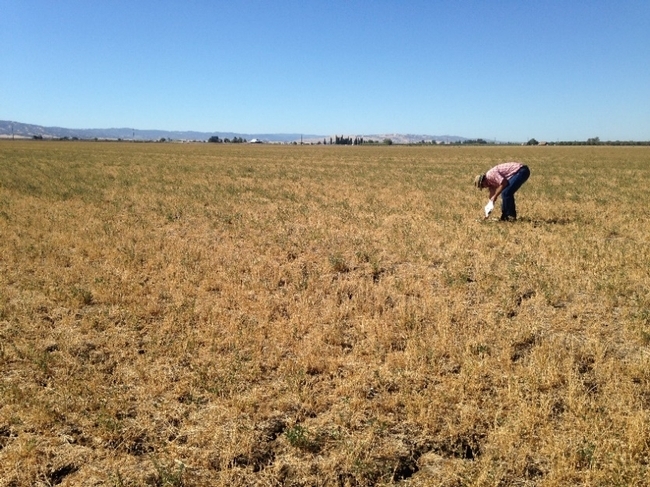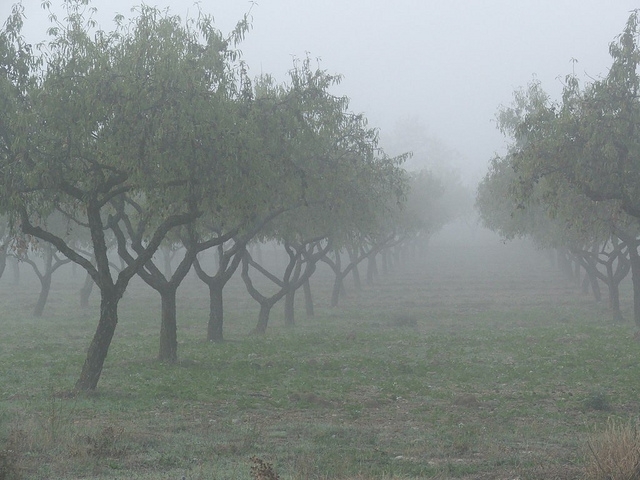Posts Tagged: Doug Parker
February 2019 news clips
Above average rainfall in February benefits strawberry crops in the Central Valley
(ABC 30) Reuben Contreras, Feb. 28
…Above average rainfall in February will help this year's harvest last through October.
"It looks like it is in full bloom right now and it looks like it is going to rain. So we need the water as much as we can right now," said Michael Yang, University of California Cooperative Extension.
He works with small farms and specialty crops in the Hmong community, including a strawberry field in Northeast Fresno near Willow and Behymer.
Yang said the rain will add to the groundwater supply most farmers use to grow their crops plus it will help make the strawberries sweeter.
Ventura County Helps Keep Farming Alive in Southern California
(KCET) Teresa O'Connor, Feb. 27
…Connecting the community to the food system is vitally important for the health of individuals and the survival of local farms, according to Rose Hayden-Smith, Ph.D., who is the editor of the UCFoodObserver.com, an online publication for the University of California (UC). A long-term county resident, Hayden-Smith was previously sustainable food systems initiative leader for UC's Ag and Natural Resources division.
“Everyone eats: everyone is a stakeholder,” says Hayden-Smith. “I would like people to be engaged with the food system, and to advocate for positive change. Think about where your food comes from and ask critical questions about the supply chain. Meet people who are involved in producing, processing, distributing and preparing the food you eat. Honor them with questions about and interest in their work.”
Gene-edited animal creators look beyond US market
(Nature) Heidi Ledford, Feb. 20
…It isn't always easy to pick up a research project and move it to a different country. About ten years ago, difficulties finding funding for his research drove animal geneticist James Murray to move his transgenic goat project from the University of California in Davis to Brazil. The goats were engineered to produce milk that contained lysozyme, an enzyme with antibiotic properties. Murray hoped that the milk could help to protect children from diarrhoea.
https://www.nature.com/articles/d41586-019-00600-4
Newly discovered nematode threatens key crops
(Farm Press) Logan Hawkes, Feb. 20
“The arrival of this nematode (Meloidogyne floridensis) in California is a little surprising — it has the potential to infect many of California's economically important crops,” says UCCE Kern County Advisor Mohammad Yaghmour. “Root samples had been collected from an almond orchard in Merced County last year, and confirmed at the California Department of Food and Agriculture's (CDFA) Nematology Lab as M. floridensis.”
Yaghmour facilitated the second discovery of the nematode in a Kern County orchard a month after the first was uncovered in an almond orchard in Merced County.
https://www.farmprogress.com/tree-nuts/newly-discovered-nematode-threatens-key-crops
Ag Innovations Conference and Trade Show returning to Santa Maria for third event
(Santa Ynez Valley News) Mike Hodgson, Feb. 19
The Ag Innovations Conference and Trade Show will return to Santa Maria for its third event, this time focusing on biologicals, on March 5. The deadline for discounted early registration is next week.
… Considering the growing interest in biologicals and the demand for sustainably produced food, organizers selected topics on biocontrol agents, biostimulants and botanical and microbial pesticides and fungicides for the third conference, said organizer Surendra Dara, UC Cooperative Extension adviser for entomology and biologicals.
“The use of biocontrol agents, biopesticides, biostimulants and other such tools is gradually increasing in our efforts to produce with sustainable practices,” Dara said.
Almond Update: Orchard Recycling Research Showing Strong Results
(AgNet West) Taylor Hillman, Feb. 14
Orchard recycling research has been going on for over 10 years. UC Cooperative Extension Advisor Brent Holtz has been leading the project and said they continue to see positive results. There is an expense that comes with the practice but Holtz said their longest trial is making that cost back in added production.
http://agnetwest.com/almond-update-orchard-recycling-research
NASA tech helps agriculture
(Hanford Sentinel) Julissa Zavala, Feb 13,
…In keeping with the expo's theme, “Harvesting Technology,” NASA Administrator Jim Bridenstine visited the International Agri-Center in Tulare and spoke about how technology originally developed for space exploration is now being repurposed and used to improve numerous aspects of agriculture around the world.
…The measurement, also taken with LIDAR, can be used to calculate precise irrigation needs of plants and crops. Bridenstine said this pilot program, in partnership with the University of California Cooperative Extension and other agencies, is only being used in California.
UC Davis, wine industry cultivate relationship
(Fruit Growers News) Robin Derieux, Feb. 13
Under the hot summer sun of the San Joaquin Valley, just south of Merced, Miguel Guerrero of The Wine Group is trying a new high-wire act. In collaboration with University of California-Davis Cooperative Extension, Roduner Ranch vineyard manager Guerrero is experimenting with Cabernet Sauvignon vines and other varieties elevated by a single wire at 66 inches – plantings that are 2-3 feet higher than the traditional winegrape canopy.
…“The beauty of the high-wire system is that the fruit zone is really defined – a solid wall of grape clusters – and the pruning machine can just zip right alongside the vines,” said Kaan Kurtural, a UC Davis Cooperative Extension viticulture specialist. “We can carry more crop, and with mechanical leaf removal, we get that sun-dappled exposure that feeds the fruit. Less leaf cover means the vines require less water, and the grape quality is much better.”
https://fruitgrowersnews.com/article/uc-davis-wine-industry-cultivate-relationship
There's Still So Much We Need To Learn About Weed—And Fast
(Wired) Matt Simon, Feb. 11
… But late last month, UC Berkeley opened the Cannabis Research Center to start tackling some of these social and environmental unknowns. With its proximity to the legendary growing regions of Northern California, the center can start to quantify this historically secretive industry, measuring its toll on the environment and looking at how existing rules affect the growers themselves. The goal is to create a body of data to inform future policies, making cannabis safer for all.
… So for the past few years Van Butsic, codirector of the Cannabis Research Center, and his colleagues have been sifting through satellite images to pinpoint those unaccounted-for farms. “We have an army of undergraduates who look at high-resolution imagery and digitize how big the farms are, how many plants we can see,” Butsic says. Because cannabis plants love light, growers usually keep them out in the open. The researchers still miss many trespass growers, however, who tend to hide their plants in the brush to avoid detection.
https://www.wired.com/story/theres-still-so-much-we-need-to-learn-about-weed
Cultured meat: Good or bad, promise or peril?
(Agweek) By Jonathan Knutson, Feb. 11
…To Alison Van Eenennaam, University of California-Davis Extension specialist in animal biotechnology and genomics, proponents of cell-based meat are "overhyping the environmental benefits" and providing an incomplete, misleading case for it.
https://www.agweek.com/business/agriculture/4568613-cultured-meat-good-or-bad-promise-or-peril
Broomrape Weed Spreads Quickly
(AgNet West) Taylor Hillman, Feb. 8
By the time you see broomrape weed in your fields, it may be too late. There has been a resurgence of broomrape reports over the last decade in California. Retired UC Cooperative Extension Farm Advisor Gene Miyao said although the parasitic weed is far from widespread, it could become so quickly. “The seeds are very small, the growth is primarily underground until it starts sending up shoots and then it very quickly starts setting seed,” he said. “A single seed attached to a tomato plant may send up half-a-dozen shoots, and each shoot might have 1,000 seeds or more.”
http://agnetwest.com/broomrape-weed-spreads-quickly/
New CA Bill Aims to Help Prepare Farmers for Extreme Weather, Changing Climate
(YubaNet) CalCAN, Feb. 7
The state and University of California have made significant investments in research to better understand agriculture's unique vulnerabilities and adaptation strategies to a changing climate, including in the state's recently released Fourth Climate Change Assessment. But not enough has been done to translate climate risks to the farm level and assist farmers in adapting to climate change.
…The bill would also fund trainings for technical assistance providers and agricultural organizations. According to a 2017 survey of 144 University of California Agriculture and Natural Resources staff, 88% of respondents believe it is important to incorporate climate change information into farm extension programs, but only 43% actually do. Respondents cited a lack of access to climate information relevant to farmers and expressed interest in education on technical tools and information resources.
Top administrators from UC ANR visit Imperial Valley
Imperial Valley Press
They were also briefed about UCCE and DREC projects, accomplishments and barriers by the directors, county advisors and CES representatives.
Drought concerns loom for California farmers, ranchers despite recent rain
(KSBY) Dustin Klemann, Feb. 6
Even with the onslaught of rainy weather, the U.S. Drought Monitor states San Luis Obispo County and Santa Barbara County remain in a moderate drought.
On Wednesday, the UC Cooperative Extension held a workshop in Solvang titled “Weather, Grass, and Drought: Planning for Uncertainty.”
“Leave it to a drought workshop to bring the rain,” Matthew Shapero joked. He is a livestock and range advisor for UCCE.
Shapero pointed out a call he received questioning the monitor's accuracy on a local level.
“He said ‘I really don't think the drought monitor accurately reflects what I am seeing on the ground.'”
… “We Californians are constantly accused of not having seasons. We do,” said Dr. Royce Larsen, an advisor of the UCCE. “We have fire, flood, mud, and drought. That's what we live with. And it's getting more and more so every year.”
California legislators honor Summit's Steward Leader Award Winners
(California Economic Summit, Feb. 5
Monday, February 4 was a red-letter day for stewardship in California. Not only was the California Legislature celebrating the Chinese Lunar New Year and “National Wear Red Day” as a symbol of support for women's heart health, but members of both houses also paused to recognize Glenda Humiston and Paul Granillo as recipients of the California Economic Summit's 2018 Steward Leader Awards.
Revealed: how big dairy pushed fattier milks into US schools
(Guardian) Jessica Glenza, Feb. 4
…A nutritionist for the University of California called the idea that chocolate milk could help athletes “preposterous”.
“Milk is a very healthy beverage, it's got protein, calcium, vitamin D – there's a reason we are mammals and grow up drinking milk,” said Lorrene Ritchie, the director of the Nutrition Policy Institute at the University of California. “There's nothing about adding chocolate to it that's going to help an athlete.”
https://www.theguardian.com/us-news/2019/feb/03/revealed-dairy-lobby-fat-milk-trump-sonny-perdue
California's water paradox
(Morning Ag Clips/The Conversation) Faith Kearns and Doug Parker, Feb. 4
These days, it seems everyone is looking for a silver bullet solution to California's drought. Some advocate increasing supply through more storage, desalination or water reuse. Others propose controlling demand through conservation or restriction of water use by urban and agricultural users.
https://www.morningagclips.com/californias-water-paradox
Camp Fire: When survival means shelter
(Mercury News) Lisa Krieger, Feb. 2
“We have to talk about it, as a community, to reduce vulnerability – especially for citizens who don't drive,” said Scott Stephens, co-director of UC-Berkeley's Center for Fire Research and Outreach. “In the Camp Fire, people didn't die because they wanted to stay. They had to stay. All of a sudden, the fire was at their front door step.”
For Australia's policy to work in California, residents must be physically and mental trained, said wildfire specialist Max A. Moritz with UC's Division of Agriculture & Natural Resources. In Australia, which conducts formal training, “there is active participation from homeowners … so both homes and people are better prepared.”
https://www.mercurynews.com/2019/02/02/wildfires-when-survival-means-shelter/
CDFA and UC ANR join forces to advance climate-smart agriculture in California
California Secretary of Agriculture Karen Ross and UC Agriculture and Natural Resources vice president Glenda Humiston signed a memorandum of understanding in Sacramento Oct. 26 to initiate a new partnership to advance climate-smart agriculture in California.
This partnership will provide $1.1 million to hire 10 UC Cooperative Extension community education specialists who will be deployed to 10 counties statewide to assist and encourage farmers to participate in CDFA programs aimed at increasing adoption of smart farming and ranching practices.
“Agriculture is an important part of the climate solution,” Ross said. “This funding enables CDFA and UC ANR to partner with farmers to scale-up climate smart agricultural practices.”
The new program is funded by California Climate Investments dollars through the Strategic Growth Council (SGC),
“Farmers and ranchers are key to carbon sequestration and a sustainable California,” said SGC chair Ken Alex. “The Strategic Growth Council is pleased to fund this partnership for smart agricultural practices.”
The partnership is focused on implementing on-farm solutions to improve soil health, nutrient management, irrigation management, on-farm composting and manure management – smart farming practices that reduce greenhouse gas emissions into the atmosphere.
- State Water Efficiency and Enhancement Program
- Healthy Soils Program
- Alternative Manure Management Program
“This new joint effort reflects our commitment to extending research-supported solutions to our farming community so they have the information and tools they need to make climate-smart decisions,” Humiston said. “It also demonstrates our shared goal of promoting new practices that are grounded in science.”
The 10 new education specialists will serve in Mendocino, Glenn, Yolo, San Joaquin, Merced, Kern, Imperial, San Diego, San Luis Obispo and Santa Cruz counties.
Three UCCE advisors will mentor and assist the new educators: water quality and management advisor Laurent Ahiablame, based in San Diego County; area dairy advisor Betsy Karle, based in Glenn County; and irrigation and cotton advisor Dan Munk, based in Fresno County.
In addition to working with the new educators, the UCCE advisors conduct research on farming and ranching practices that boost efficiency and protect the climate, therefore serving as a conduit between discovery and implementation.
“This is a great opportunity to really support growers find the right balance between food production and effective management of natural resources,” Ahiablame said. “With the 10 community education specialists we will be one step closer to the producers across the state. I look forward to the opportunity to mentor these specialists, who in turn will be making direct impacts on the community.”
Karle said she was interested in participating in the program as a way to encourage dairy operators to try practices they are interested in but consider too costly.
“I've worked here locally with dairy producers who wanted to implement practices but need financial assistance in order to make it feasible,” Karle said. “They need assistance in the grant application process and technical support to make changes on their farms.”
Doug Parker, director of the UC California Institute for Water Resources, is the UC ANR point of contact and liaison with CDFA. To contact Parker, email doug.parker@ucop.edu.
UC and Israel sign agricultural research agreement
Pledging to work together to solve water scarcity issues, Israel's Agricultural Research Organization signed a memorandum of understanding with UC Division of Agriculture and Natural Resources and UC Davis on July 16. The signing ceremony kicked off the 2018 Future of Water for Irrigation in California and Israel Workshop at the UC ANR building in Davis.
“Israel and California agriculture face similar challenges, including drought and climate change,” said Doug Parker, director of UC ANR's California Institute for Water Resources. “In the memorandum of understanding, Israel's Agricultural Research Organization, UC Davis and UC ANR pledge to work together more on research involving water, irrigation, technology and related topics that are important to both water-deficit countries.”
The agreement will enhance collaboration on research and extension for natural resources management in agriculture, with an emphasis on soil, irrigation and water resources, horticulture, food security and food safety.
“It's a huge pleasure for us to sign an MOU with the world leaders in agricultural research like UC Davis and UC ANR,” said Eli Feinerman, director of Agricultural Research Organization of Israel. “When good people, smart people collaborate the sky is the limit.”
Feinerman, Mark Bell, UC ANR vice provost, and Ermias Kebreab, UC Davis professor and associate vice provost of academic programs and global affairs, represented their respective institutions for the signing. Karen Ross, California Department of Food and Agriculture secretary, and Shlomi Kofman, Israel's consul general to the Pacific Northwest, joined in celebrating the partnership.
“The important thing is to keep working together and develop additional frameworks that can bring the people of California and Israel together as researchers,” Kofman said. “But also to work together to make the world a better place.”
Ross said, “It's so important for us to find ways and create forums to work together because water is the issue in this century and will continue to be.”
She noted that earlier this year the World Bank and United Nations reported that 40 percent of the world population is living with water scarcity. “Over 700,000 people are at risk of relocation due to water scarcity,” Ross said. “We're already seeing the refugee issues that are starting to happen because of drought, food insecurity and the lack of water.”
Ross touted the progress stemming from CDFA's Healthy Soils Program to promote healthy soils on California's farmlands and ranchlands and SWEEP, the State Water Efficiency and Enhancement Program, which has provided California farmers $62.7 million in grants for irrigation systems that reduce greenhouse gases and save water on agricultural operations.
“We need the answers of best practices that come from academia, through demonstration projects so that our farmers know what will really work,” Ross said.
As Parker opened the water workshop, sponsored by the U.S./Israel Binational Agricultural Research and Development (BARD) Program, Israel Agricultural Research Organization and UC ANR, he told the scientists, “The goal of this workshop is really to be creating new partnerships, meeting new people, networking, and finding ways to work together in California with Israel, in Israel, with other parts of the world as well.”
Drawing on current events, Bell told the attendees, “If you look at the World Cup, it's about effort, it's about teamwork, it's about diversity of skills, and I think that's what this event does. It brings together those things.”
Drought tips available for farmers
Drought strategies for managing alfalfa and many other crops are available free from UC Agriculture and Natural Resources. As California endures a fourth year of drought and ever-tightening water supplies, water-management strategies have become even more critical to farmers.
To help farmers make the best use of the water they have available, a series of new and updated drought tips fact sheets has been developed by UC ANR scientists and funded by the California Department of Water Resources.
“These drought tips provide irrigation management recommendations for a broad range of agricultural crops and under different water supply conditions,” said Daniele Zaccaria, UC ANR Cooperative Extension agricultural water management specialist at UC Davis and major organizer of the drought tip series. “The information in these tips will be of practical use for growers and other water-related stakeholders now and into the future as our agricultural community continues to adapt to climate variability and to a changing water supply situation.”
UC ANR scientists have identified best management practices for a wide range of annual and permanent crops and irrigation systems and methods during the drought. In the drought tips series, they also give advice for managing soil salinity and using shallow groundwater for irrigating crops. For beef cattle, they provide recommendations for culling herds and feeding to supplement grazing.
The following drought tips are currently available for free download at http://ucanr.edu/drought-tips:
- Drought strategies for alfalfa
- Drought management for California almonds
- Use of shallow groundwater for crop production
- Drought strategies for walnuts
- Fog contribution to crop water use
- Reclaiming Saline, Sodic and Saline-Sodic Soils
Decades of UC ANR research underlie the information contained in the drought tips. In the 1970s and again in the 1990s, UC ANR partnered with DWR to develop a series of drought management fact sheets.
“DWR has worked with UC ANR to update the drought tips and make sure the latest and best information on water management is available to growers,” said Peter Brostrom, DWR Water Use Efficiency Section Manager.
The California Institute for Water Resources, which coordinates water-related research and extension education across the 10 UC campuses and UCANR, has the drought tips and more drought resources online at http://ciwr.ucanr.edu.
“Even if El Niño brings rain this fall, water scarcity will continue to impact California farmers,” said Doug Parker, director of UC ANR's California Institute for Water Resources. “As climate change continues to reduce the average annual snowpack, it is likely that droughts in California will become more frequent and severe in the years to come.”
UC ANR's California Institute for Water Resources and the California Department of Water Resources also offer drought-related information in a series of videos. Water experts from UC and other agencies and institutions have recorded presentations on high-priority drought topics. Currently 38 videos can be accessed for free on computers and mobile devices at http://ucanr.edu/insights.
UC Agriculture and Natural Resources researchers and educators draw on local expertise to conduct agricultural, environmental, economic, youth development and nutrition research that helps California thrive. Learn more at ucanr.edu
Water policymaking gets a boost from the drought
Droughts, typically slow-moving disasters that unfold over a period of years, tend to provide opportunities to make policy changes that improve long-term water management regulations in California, said Doug Parker, the director of the UC Agriculture and Natural Resources California Institute for Water Resources. Parker was a guest on City Visions, a call-in talk show on San Francisco's local public radio station KALW.
"This is one of the things that has happened in past droughts," Parker said. "If you look at the drought of 1976-77, that was the beginning of a push for irrigation efficiency in California. The state put money into weather stations across the state."
The drought that ran from the late 80s to early 90s led to changes in state law that partially opened up the opportunity for water markets in California. The current drought has resulted in new groundwater management legislation.
The focus of the hour-long program, hosted by David Onek, was the impact of the drought on the food Californians eat.
Parker explained that the state's agricultural industry is part of the global food market. If California residents choose to eat foods from other areas to reduce their water footprints, they are likely increasing their environmental footprint due to impacts in those other places and transportation costs.
Boycotting certain crops perceived to be water guzzlers probably won't have the intended impact either, he said.
"Growers will shift what they do because of the drought," Parker said. "But these are long-term decisions. They don't have the flexibility to make quick changes because of the drought."
Nathanael Johnson, the food writer for Grist.org, was also a guest on the show. He agreed that boycotting California produce because of its water use is ill-advised.
"If you are choosing not to buy almonds or avocados from California, you're not supporting the farmer," Johnson said. "You're not putting water back in the aquifer. You are making it tougher for that farmers to make a profit. Boycotting just discourages farmers."
One of the people who called into the show asked about the affiliation and funding sources of the California Institute for Water Resources.
"It is a unit of the University of California, part of the Division of Agriculture and Natural Resources," Parker explained. "We are located at the Office of the President. We have offices in every county in the state working with growers on irrigation and other things. We are funded by the University of California and also have funding form the U.S. Geological Survey."
The same caller asked why cotton is grown in California during the drought. Johnson said there is no overarching rule that dictates what crops may be grown where.
"Individual farmers are making those decisions," he said.
Parker pointed out that California cotton acreage is just a fraction of what it used to be.
"Most of the cotton grown is of higher quality that doesn't grow as well elsewhere," he said.

